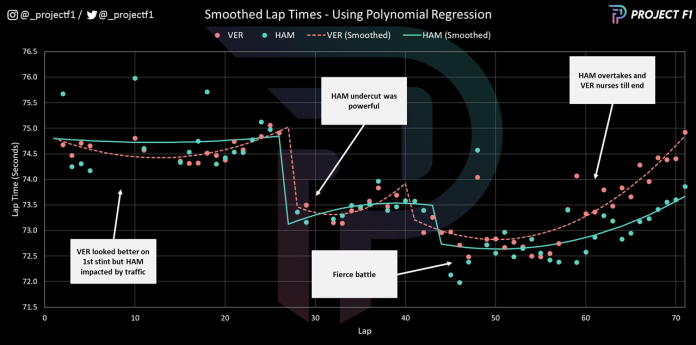Drama. The weekend of F1 was full of it. After claiming pole position in Friday’s qualifying, Lewis Hamilton was relegated to the back of the field for Saturday’s sprint qualifying due to disqualification concerning a breach of the technical regulations. This appeared to be a major blow to the Briton’s championship hopes, with his main rival starting in P1. Though defying expectations, Hamilton was able to climb to P5, setting himself for P10 grid slot due to needing to serve a separate 5 place grid penalty.
With Max Verstappen starting in P2, the odds still looked against Hamilton. Yet despite all odds, Hamilton was able to hunt down and overtake Verstappen to close the gap in the championship. Just how did Hamilton overcome an effective 25 grid place penalty to take the win? Let’s jump straight into it.
F1 Post-Race Data Analysis: Hamilton’s Performance Was More Than Just a Strong Engine
Figure 1 shows the full view of the Brazilian Grand Prix and all the key moments that contributed to Hamilton’s journey to the top step. The majority of the focus has been placed on the strength of the new Mercedes power unit in its role of helping Hamilton overtake Verstappen for the lead. And while the scenes of the overtake are dramatic and evocative, they underplay the significance of strategy, safety cars and tyre management that led to Hamilton being close enough to execute the move in the first place.
The first key element to Hamilton’s success was the early safety cars during laps 6–9 and laps 12–14. With Hamilton starting in P10 and Verstappen starting in P2, Verstappen needed to open up as large a lead against the Briton as possible. Taking the lead into turn 1 on lap was crucial for Verstappen as it allowed him the clean air to build the required gap. This is an especially important point given Hamilton was able to claim P3 from his teammate by lap 5, leaving Sergio Perez as the only lifeline for Redbull.
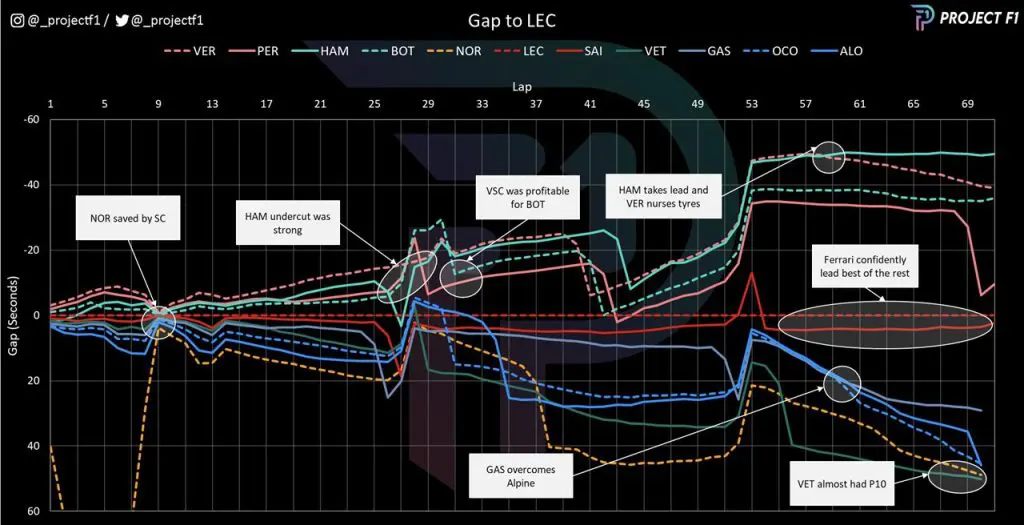
And while there was only one car between Hamilton and Verstappen, there was still a decent time gap between the pair. That is until the onset of the first safety car which eroded this gap to nothing. It was then all up to Perez to play rear-gunner and keep Hamilton at bay for as long as possible. Perez was able to do this until lap 18, giving Verstappen a buffer of almost 4 seconds. This gap stayed relatively stable as both drivers were able to go tit for tat when it came to lap times. This is where Mercedes deployed the lever of strategy.
F1 Post-Race Data Analysis: Analysis of Hamiton’s Undercut
Figure 2 highlights the gain that Hamilton was able to make on Verstappen by opting for the undercut, By pitting on lap 26 and switching to a fresh set of hard tyres, Hamilton more than halves his deficit to Verstappen.
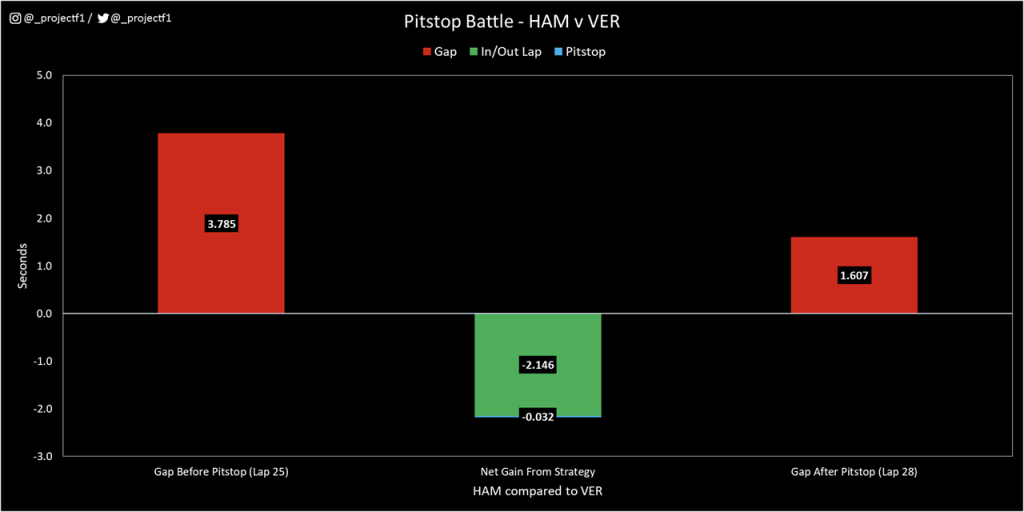
While success is usually measured in whether the driver executing the undercut gains track position, this undercut is still successful as the Hamiltons bring himself very close to the DRS range. This allows Hamilton to place significant pressure on Verstappen and tempt the Dutchman to overuse his tyres.
F1 Post-Race Data Analysis- Lap Times Compared: Verstappen vs Hamilton
Figure 3 showcases the lap times and trend pace between the two drivers across their different stints. While Verstappen had the upper hand in the first stint, Mercedes’ undercut left them vulnerable in the second stint. Hamilton’s pace on the hard tyre was very strong and given the strong straight-line speed of the Mercedes, Verstappen had to work the tyres hard through the corners of sector 2 to build a margin of safety.
But as Figure 3 shows, you can only do this for so long before you start losing the optimal performance of the tyre. All the while Mercedes was maintaining the pressure while not burning out their own tyres. Remembering the strength of the undercut, Red Bull couldn’t afford to make another strategic misstep and therefore had to make an early stop of their own.
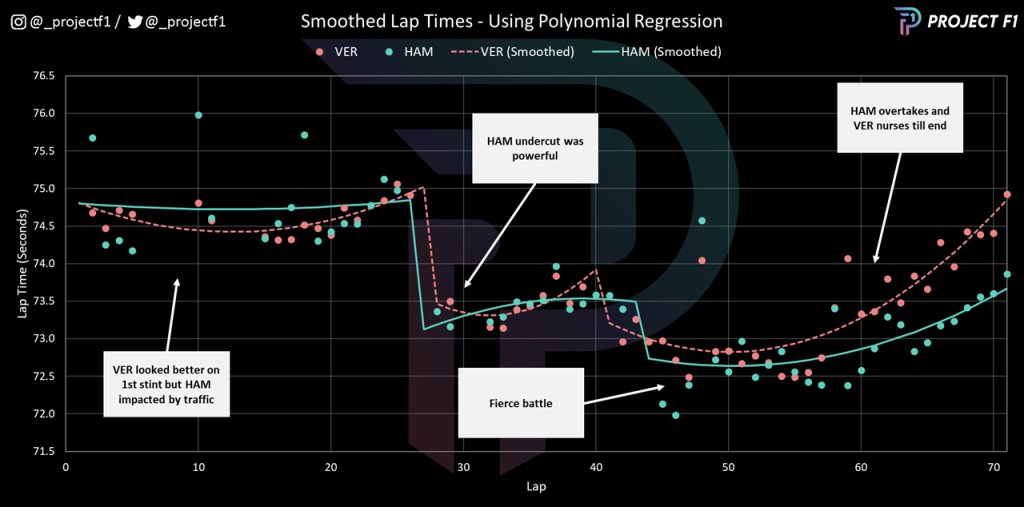
Red Bull’s earlier stop was successful in that it prevented Mercedes from pulling another undercut attempt, but was a failure in that it didn’t help build much of a gap. Furthermore, surviving the onslaught from Hamilton for 31 laps was a tall order, especially given the Mercedes has tended to perform better on harder tyres and the obvious straight-line speed advantage.
With no gap, no tyre advantage, no straight-line advantage and so much of the race to go, Hamilton’s victory was almost inevitable. And while there was drama on lap 48 with a dramatic moment in turn 4 where both cars go wide, Hamilton was able to comfortably take the lead on lap 59 as shown in Figure 1. From here, Verstappen was in management mode to make it across the line in P2.
F1 Post-Race Data Analysis-Lap Times Compared: Perez vs Bottas
How about the battle amongst the second drivers between Mercedes and Red Bull? Figure 4 above showcases how Perez was much stronger than Bottas in the first stint. The pace for the remaining two stints was more or less indistinguishable between both drivers.
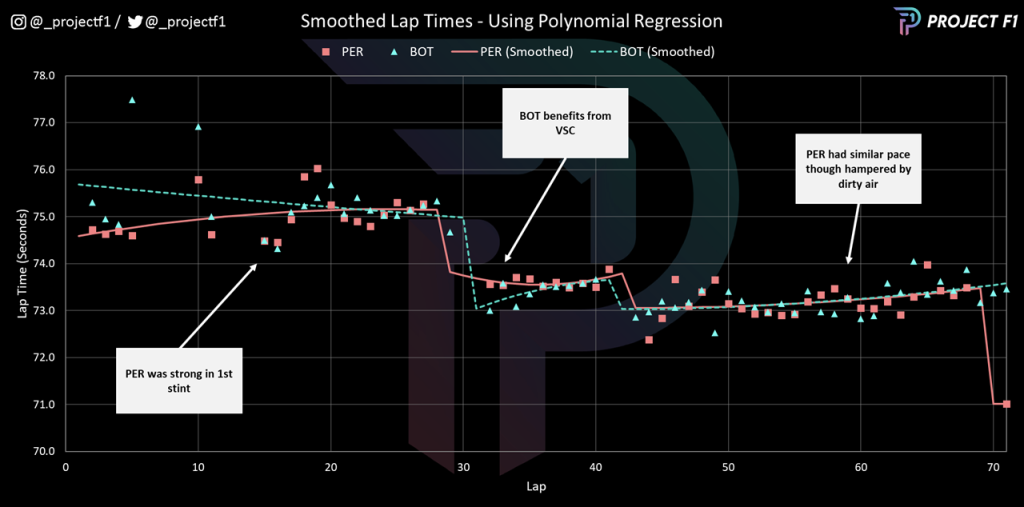
Although it’s worth remembering that Perez delivered this pace while being in the dirty air of Bottas, suggesting that the Red Bull of Perez may have been more competitive. So how did Bottas finish the race in front of a potentially faster Perez? The key variable is safety cars.
F1 Post-Race Data Analysis: Bottas’ Undercut
Perez pits on lap 28 while Bottas pits on lap 30. Figure 4 shows that Perez had the better trend pace in this interval. But this pace advantage is voided due to the virtual safety car which allows Bottas to pit while other cars are travelling at a slower rate.
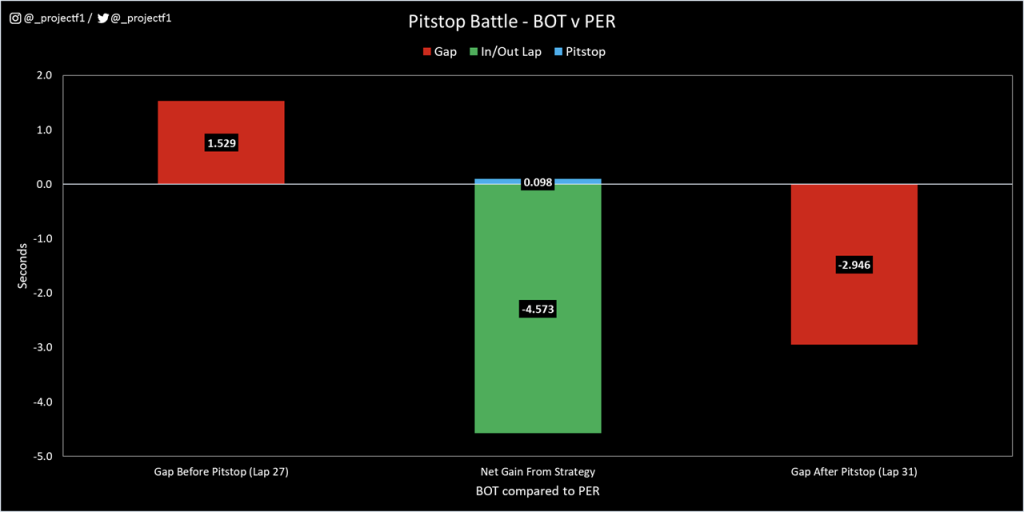
This effectively reduces the time lost under full racing speed and therefore Bottas claims track position. The quantum of this gain is illustrated in Figure 5.
F1 Post-Race Data Analysis: Ferrari Were Best of the Rest and Alpine Fell Short of Gasly
It was another strong weekend for Ferrari who extend their points advantage over McLaren in the battle for P3 in the constructor’s championship. Figure 6 above highlights the impact of Lando Norris’ costly lap 1 tangle with Carlos Sainz. Whilst unlucky in this regard, the young Briton was bailed out by the safety car for without it he would not have finished in P10. Following Daniel Ricciardo’s retirement from the race, Norris’ point was all that could be salvaged.
Figure 6 also highlights how Ferrari’s pace was head and shoulders above the rest of the field, with the gap to Pierre Gasly’s AlphaTauri only increasing throughout the race. In fact, Ferrari’s pace in the final stint was comparable to that of the front runners albeit on softer tyres.
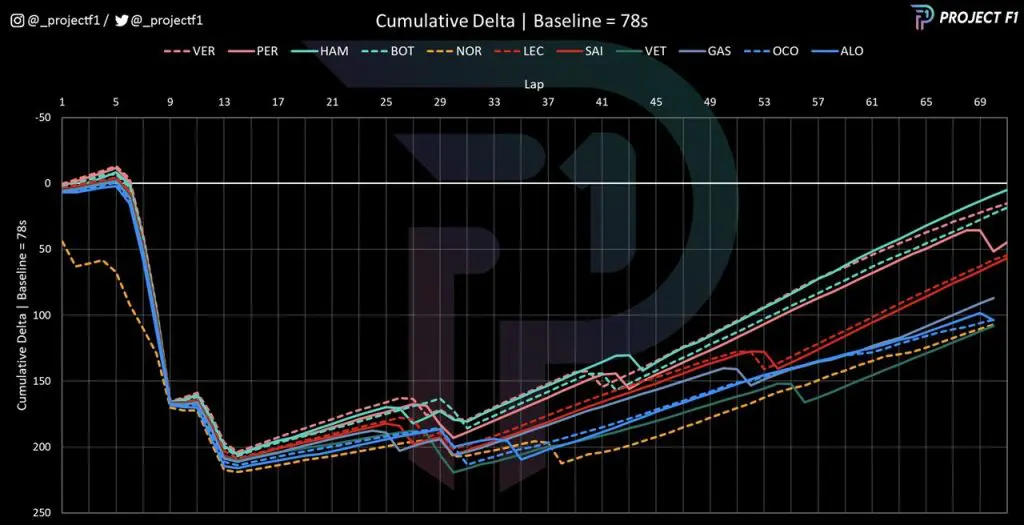
Gasly was another that had a strong race, holding off both Alpines who were attempting a one-stop strategy. The Frenchman was able to demonstrate an impressive 2nd stint which set him up for an aggressive final stint to overtake both drivers. Honourable mention goes to Sebastian Vettel for almost getting P10 off Norris in the closing stages of the race.
F1 Post-Race Data Analysis: Watchpoints for the Next Grand Prix
The next stop is Qatar. It will be a completely new circuit for F1 and is sure to throw up a curveball. With no form book to set expectations, anything is fair game. However, the strength of Hamilton’s power unit will continue to be a watchpoint going into the Grand Prix. Verstappen maintains a 14 point lead over Hamilton with 3 races remaining. Two wins for Hamilton and two second places for Verstappen will ensure both go into the final race on equal points. Everything remains up for grabs between these two.
And how will the battle between Ferrari and McLaren play out? Will Ferrari continue their form or will Mclaren bounce back? The fight between Alpine and AlphaTauri remains close as well. The permutations are narrowing as we approach the dramatic end to a stunning season. See you next time.
Author and graphic designers: Ekagra Gupta – @_ProjectF1

